I’ve received a few comments regarding Chicago Marathon winner Moses Mosop’s unique running style – the race was held on Sunday, and Mosop won with a course-record time of 2:05:37. Last night I received an email from Amby Burfoot, who had forwarded a photo of Mosop taken near the finish line at Chicago. The photo was taken by Raymond Britt of RunTri.com, and came with the comment “Literally, 4-5 inches off the ground with the finish line in sight. See shoes, concrete, shadow. Remarkable.”
Here’s the photo – click to enlarge:
Moses Mosop nearing the finish line at the 2011 Chicago Marathon – photo by Raymond Britt of RunTri.com
Back in may I wrote a post where I did a brief analysis of the running form of some of the top runners in the Boston Marathon, and Mosop was one of the group that I looked at (he finished second at Boston). Below is what I had to say about Mosop and eventual Boston winner Geoffrey Mutai:
Video 1 – Geoffrey Mutai (green singlet) and Moses Mosop (black/red singlet). Both have absolutely beautiful form. Lower leg is near vertical on ground contact for both, and both have a slight forward lean. Mutai is a midfoot striker, whereas Mosop is a true forefoot striker. Mosop has a slightly higher arm carry, whereas Mutai drops his below his waistline a few times.
I also used the above video to calculate some stride timing data – of the runners I was able to analyze, Mosop had the shortest stance time and the longest aerial time – he was the only runner of the bunch who, based on the limited number of strides available to analyze, spent more time in the air than on the ground – this probably explains why he seems to bounce and float through the air when he runs:
|
Name |
Stance | Swing | Aerial | Step | Step |
| Time | Time | Time | Time | Rate | |
| Kilel | 0.180 | 0.468 | 0.142 | 0.322 | 187.4 |
| Cherop | 0.173 | 0.497 | 0.157 | 0.330 | 181.8 |
| Davila | 0.168 | 0.450 | 0.140 | 0.308 | 194.6 |
| Goucher | 0.195 | 0.422 | 0.115 | 0.310 | 193.6 |
| Mutai | 0.178 | 0.460 | 0.140 | 0.318 | 188.5 |
| Mosop | 0.138 | 0.508 | 0.185 | 0.323 | 185.6 |
| Gebremariam | 0.170 | 0.515 | 0.168 | 0.338 | 177.4 |
| Hall | 0.193 | 0.497 | 0.152 | 0.345 | 173.9 |
In a scatterplot showing each runner plotted according to their values for swing time and stance time, Mosop came out as rather unique, mainly because his stance time is so short:
What does this mean? Perhaps nothing more than the fact that it once again shows that there is more than one way to be an elite caliber runner when it comes to running technique. Mosop seems to have a very distinct, almost bouncing gait, and it was good enough to set a course record in Chicago. A few people have sent me photos of Patrick Makau, who recently set the marathon world record in Berlin – it’s very hard to say for sure from still photos, but indications suggest he may be a mild heel striker (photo below from Photorun.net). Mutai, who won Boston, seems to be a midfoot runner. Three really fast guys, three seemingly different techniques – as always, variation is the norm rather than the exception!
Patrick Makau at Berlin – via Photorun.net
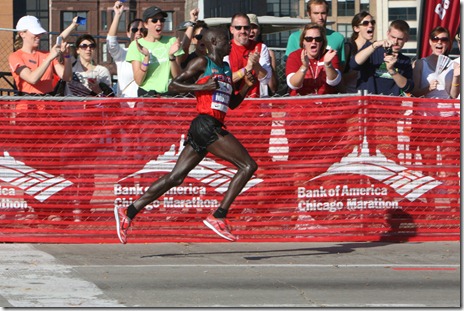

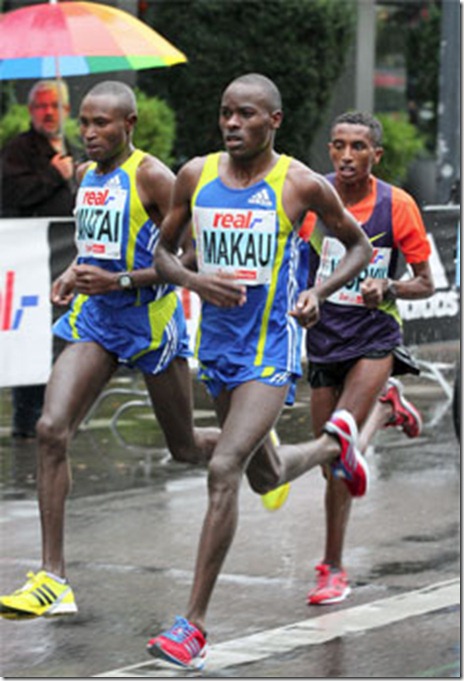
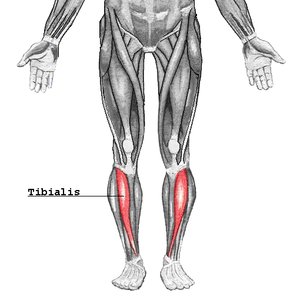
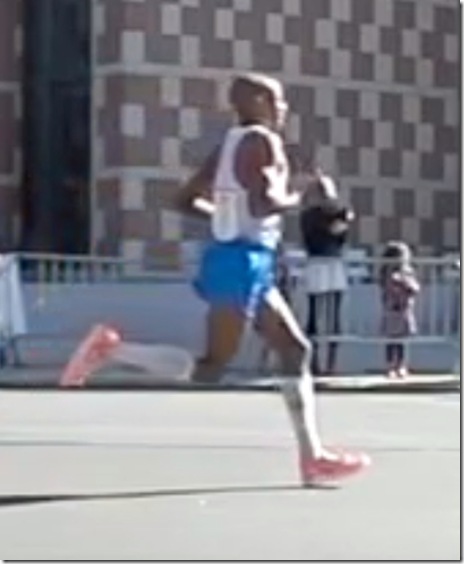
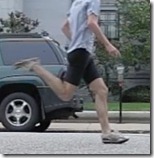
















I saw Mosop first-hand as an injury unfortunately pulled me off the course. Consequently, I made a video of the lead elite pack at miles 1.5, 13.1, 16.5 and the finish, and posted it last night to my blog at http://runinamerica.com
What’s amazing about the gait of the first five finishers is that their pace, though an amazing ~4:40-4:50 doesn’t *seem* fast at all. Frankly I’m a bit perplexed since normally I’m quite accurate in assessing the approximate speed of other runners with a quick glance, but these elites totally shift my perspective since they look so naturally relaxed!
Thanks for posting this data again, Pete. And thanks for the video, Mark. I also watched the race in Chicago, and it’s also worth noting that Mosop runs with his head tilted back (like a sprinter) and his torso twisted significantly to one side — two quirks that I would normally try to eliminate in an amateur distance runner’s form. However, clearly there is no need to tamper with Mosop’s running style! In fact, seeing him run, as well as seeing the pictures and data you have posted on the form(s) of other elites, makes me want to rethink the practice of messing around with people’s form to begin with…Aside from discouraging something like a runner’s tendency to overstride dramatically, maybe we should leave well enough alone.
Yes, there’s variation amongst elite runners but when Mosop runs 2:02 will we say it’s *because* of his springy stride? That his short stance time, long aerial time is why he’s minutes faster than other runners?
I’d love some high-speed data on Paula Radcliffe. She also has a springy stride and was minutes faster than other elite women marathoners.
I’m sure some will. However, it’s very hard to tease apart just what makes one elite better than another. Could be technique, but could also be better training, physiology, etc. Or maybe oner was just in better shape on a given race day.
Great post! What do you think of this guy’s form vs. the kids on the adjoining page?
http://runnersworld.coverleaf….
Overstriding is allowed if you are running away from a fire breathing dragon :)
Pete:
Thanks for making the excellent point that elite runners may be heel-strikers, midfoot-strikers or forefoot-strikers and also making the point that what area of the sole of the shoe first strikes the ground is only one of the multitude of factors which contribute to racing performances in runners.
In my years of sports podiatry practice, I have always emphasized to runners that they should not try to change their running form drastically (i.e. going from a forefoot striker to a heel striker or going from a heel striker to a forefoot striker) and that they should choose the running form that feels most relaxed and economical to them. And during this time, as Runningcoach also stated, the main change I will make in less experienced runners is to tell them to chop their stride (i.e. shorten stride length and increase stride frequency) when I see them overstriding. I believe way too much time is currently being spent here, and on other forums, on “analyzing form”, when, in fact, there are so many other factors that can improve running performance and decrease injury rate such as improved sleep patterns, better diet, better training methods, cross-training, etc.
By the way, Irene Davis, PhD, and I had our “Barefoot Running Debate” at the California Physical Therapy Association’s Annual Conference in Long Beach, California a few weeks ago. It was standing room only in the auditorium and we both had lots of fun. From the response of the crowd, there is still plenty of interest on the topic of barefoot running vs shod running and we will be doing the debate again at the American College of Sports Medicine Annual Meeting next June. Hopefully, out of all this discussion, some valuable information will be produced that will help all runners be healthier and happier in their running activities.
Cheers,
Kevin A. Kirby, DPM
Sacramento, CA
On a related note there’s an interesting breakdown of Makau’s WR performance compared with Gebrselassie’s WR that Makau broke on The Science of Sport: http://www.sportsscientists.co…
Just wondering, is form like this even practical for the recreational runner?
Great question, and I have no idea :) I’d be hesitant to recommend emulating anybody’s specific form as we are all different, but there are certainly universal rules we can probably all follow – e.g., don’t stick your foot way out in front of your knee at ground contact…
Let’s not forget the woman’s winner.
Yes, and as they point out in that thread, she heel strikes, but does not appear to overstride (like Meb). It’s the combo that seems to be the problem. As I like to say, there’s more than one way to be a heel striker.
Which is what we agreed upon on RunnersRoundTable. All heel-strikers are not created equal and the key is the big “O”, Overstriding.
Pete, what is the difference between “swing time” and “aerial time”? Thanks.
Swing time is time from toe off to next contact of the same foot. Aerial time or flight time is when both feet are off the ground simultaneously, as in the picture of Mosop at the top of this post.
Sent from my iPad
Just came across the following link from Steve Magnes’ twitter feed on http://www.scienceofrunning.co… :
link to futurity.org…
The interesting part for me is how the turkeys are pre-activating their muscle to prevent them from lengthening on impact, instead using their tendons to handle the impact, then post impact letting their muscles lengthen. Is this happening to us when we run? I would guess it’s quite likely, especially for those of Moses Mosop :-)
I actually sent that link to Steve :) i had Mosop in mind when i read that turkey article…it’s a good question, and I’m not sure of the answer, but i suspect it might be the case.
Sent from my iPad